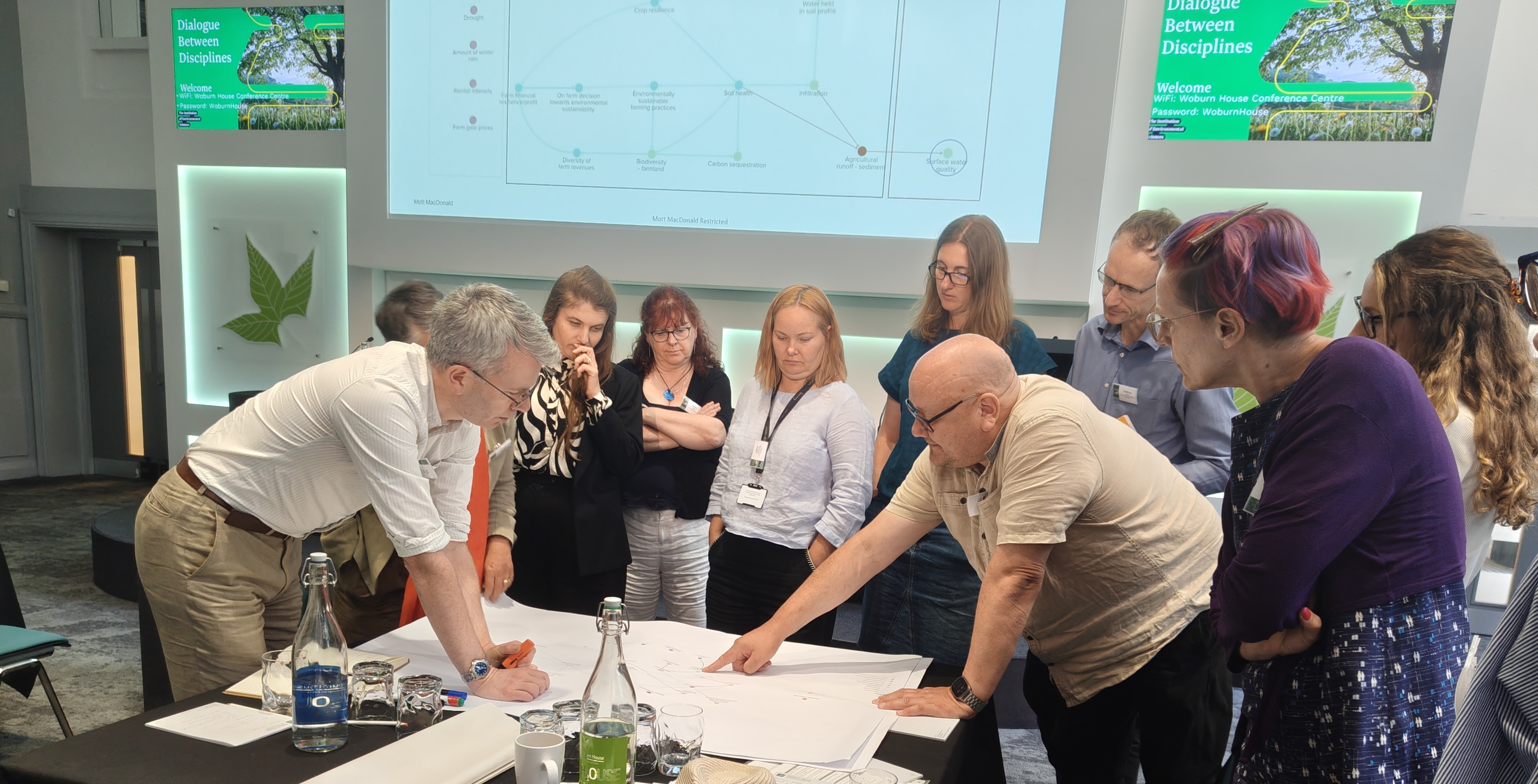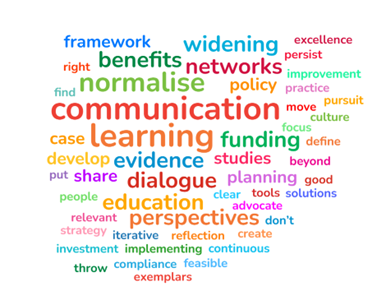Enabling interdisciplinary collaboration is vital to unlocking a sustainable society and tackling the complex, interconnected challenges of climate change, biodiversity loss and environmental pollution. It is widely acknowledged that no single sector can address these in isolation, and there is a danger of responding in a siloed manner, which could lead to unintended consequences or suboptimal solutions. Interdisciplinarity of all types – across disciplines, sectors and job types - is required to develop solutions that can deliver multiple benefits for both people and nature.
The IES is at the forefront of uniting the interdisciplinary field of environmental science around a shared goal: to work with speed, vision, and expertise to solve the world’s most pressing environmental challenges, together. The IES is uniquely placed to support interdisciplinary dialogue, having both the breadth - with our membership spanning specialisms, sectors and job types within the environmental profession - and the technical depth of expertise.
In recognition of the importance of facilitating collaboration across the environmental sciences we held our inaugural Dialogue Between Disciplines conference in 2024, with the support of our member-led Communities. This pioneering conference is dedicated to fostering collaboration and knowledge-sharing between environmental professionals and related sectors, to support the development of multifunctional solutions through science and connections.
With the first conference establishing that this agenda was critical for the sector, the second Dialogue Between Disciplines, held on the 23rd June 2025, focused on supporting attendees to develop interdisciplinary and systems thinking skills and knowledge that can be embedded in their day-to-day work. The development of the conference was led by an interdisciplinary organising committee made up of representatives from each of our Communities, bringing in perspectives on land, air, water, policy implementation and education.
Walking the talk
The IES has long been an advocate for systems thinking approaches and interdisciplinarity. In 2024, we took our commitment to the next level with the development and publication of our 2024-2027 Strategy, titled Enabling interdisciplinary solutions through science and connections. This strategy embeds interdisciplinarity as a core aspect of our work, underlining the need for an environmental science profession that is connected, collaborative and challenge-focused.
Our member-led Communities provide a key vehicle for supporting interdisciplinary working. Some of our Communities are challenge-based, and are therefore interdisciplinary by nature, and our specialism-based Communities are already coming together and collaborating with others on cross-cutting issues. Examples include:
- IAQM and Land Condition Community have developed joint guidance on Good practice on air quality monitoring for brownfield projects
- EPIC and EIA Community are collaborating on the BNG in Practice project
- EIA Community held an event with the Climate Action Community and Chartered Institute for Archaeologists – Digging deeper for net zero
Boundaries and borderlands
The 2025 Dialogue Between Disciplines conference began with presentations focused on what is needed to support interdisciplinarity in practice, including exploring how this is already being done in the sector through the Circular Economy Taskforce.
IES Vice President and Chair of our Environmental Policy Advisory Committee (EPAC) Gary Kass kicked off the conference exploring what the necessary conditions are for effective boundary-crossing to support working across science, policy and practice. Gary highlighted that the boundaries between science, policy and practice are not clearcut or linear. The 'borderlands' are areas between disciplines where they interact and overlap, and are often complex, dynamic and unpredictable. Exploring and understanding these areas is an important part of supporting interdisciplinarity across sectors and specialisms. To properly traverse these borderlands and allow for boundary-crossing, Gary suggests the following conditions are necessary:
- Intentions – ensure the intentions are set from the beginning
- Settings – create specific settings for the boundary-crossing to occur
- Questions - develop and pursue questions that cannot be addressed adequately through a single discipline or organisation
- People – Get the right people in place to take it forward and champion the work
Professor Paul Ekins OBE then applied Gary’s conditions to the work of the Circular Economy Taskforce, which operates directly within the borderlands of science, policy and practice. The Taskforce brings together expertise from across disciplines with the aim to develop a strategy for a circular economy in England, alongside sector-based roadmaps, that can minimise environmental impacts, support net zero ambitions, support efficiency of resource use, and support economic growth.
Both of these presentations emphasised the importance of systems thinking approaches for supporting interdisciplinarity and solutions development; only through understanding the system as a whole, the interdependencies between parts of the system, and key stakeholders within a system, can effective and sustainable solutions be developed.
Tools to support interdisciplinarity and systems thinking
Systems thinking should underpin approaches to interdisciplinarity. However, this can be difficult to do in practice, especially when bringing together diverse expertise and insights. Through interactive workshops and presentations, we explored tools and methods that can support systems thinking and interdisciplinarity within environmental work.
Systems diagramming is a powerful tool for supporting a systems approach. It can support understanding of the interrelationships that exist within a system, multiple stakeholder perspectives, and help to define the boundaries of the system being explored (albeit often a theoretical construction). Diagramming approaches include rich pictures, systems maps, influence diagrams, multiple cause diagrams and causal flow diagrams. These can all be a valuable way of supporting collaboration, stimulating discussion on a subject, developing a holistic understanding of a topic, and communicating complex topics effectively.
Systems diagramming was then used in a follow-up workshop hosted by Justin Brassett, Declan Sealy and Marieke Nieuwaal from Mott MacDonald, which challenged delegates to consider how nature-based solutions in the water sector can be considered from a systems perspective, allowing for diverse viewpoints to be accounted for and multiple benefits to be unlocked.

Digital tools were also highlighted as an important part of supporting interdisciplinarity and systems thinking. The advent of new imaging software and online tools can allow for different data sources to be combined and visualised in simple, intuitive ways helping for a more holistic understanding of an area. Digital tools are also a powerful communication and engagement tool across stakeholders, enabling communication of complex processes in simple ways.
Interdisciplinarity in practice
Environmental scientists cannot work in a vacuum to develop solutions – even collaboration across environmental science disciplines will not be enough. To drive change, environmental scientists need to collaborate with those further afield, such as with policymakers, the construction industry and public health organisations. Social scientists in particular will be a critical discipline to engage to support effective engagement with key stakeholders, drive evidence-based behavioural change, and enable more effective impact of environmental work.
With this in mind, the IES has been working with ACCESS, a funded programme of work providing leadership on the social science contribution to tackling and solving a range of climate and environmental problems. Professor Birgitta Gatersleben joined the event to share learnings from ACCESS so far. She highlighted how environment social science produces a wide range of methods and knowledge to solve problems, understand human-environment interactions, and develop innovative solutions.
Other examples of interdisciplinarity in practice explored included considering the issue of air pollution and its management through the lens of the UN Sustainable Development Goals, the application of systems thinking to support the implementation of nature-based solutions in the water sector, and the role of place-making in supporting an environmentally informed approach.
The key to bridging the gaps between disciplines - communication
The final part of the day focused on the important role of communication in facilitating interdisciplinarity and driving transformative change, a key theme from discussions at the inaugural conference in 2024.
Diana Pound from Dialogue Matters explored the role of communication, collaboration and participatory dialogue in supporting better decision making and the delivery of transformative outcomes. She highlighted the importance of harnessing conflict, understanding behaviour and processes of decision-making, and true participation.
This underpinned the importance of engaging further with social scientists at the outset of environmental work, to ensure evidence can be used effectively and impact maximised.

The day finished with Diana facilitating a workshop on a tool to support communication: six thinking hats. Delegates used six thinking hats to consider the idea of Dialogue Between Disciplines. The wordcloud above captures the responses from the group with the ‘green hat’ on – questioning what else do we need to do around dialogue between disciplines.
What next?
The Dialogue Between Disciplines conference will be returning in 2026, but for the IES this is ongoing piece of work, not a single conference in the year.
We will continue to champion and facilitate interdisciplinary work here at the IES, harnessing the expertise and enthusiasm within our Communities and bringing them together to discuss cross-cutting issues that exist at the ‘borderlands’ of their specialisms.
We will also seek to deepen our engagement with other disciplines, including the social sciences, so that we can continue to forge partnerships and share knowledge that can drive solutions to the environmental challenges that we face.
We will continue publishing case studies, exploring best practice and developing practical toolkits to aid interdisciplinary working. In Autumn, the next issue of our environmental SCIENTIST journal, will focus on interdisciplinarity.
As we continue our journey into the borderlands of environmental science, through facilitating and enabling interdisciplinary collaboration, discussions at Dialogue Between Disciplines have taught us three key things for a successful journey:
- Prepare well - we must ensure that we have a good understanding of the system we will be entering, who the key stakeholders are, potential allies and challengers, and the influence they have. This will help us to make sure our journey is efficient and effective.
- Pack well - we need to understand and utlise the toolkits, methodologies and frameworks that can support our journey.
- Prioritise well - there will be multiple paths to take through the borderlands, we should choose our path wisely, understanding the trade-offs between different routes, not try to move too quickly, and not be afraid to reorient and change course when the evidence tells us to. This will help us to ensure that our journey has the most positive impact that it can.
How can I get involved?
If you are a member of the IES why not join one of our member-led Communities? This will provide you with the opportunity to engage further with our work and help shape Dialogue Between Disciplines in the future. If you have an idea for what you would like to see at a future conference, please don’t hesitate to get in touch.
You can also join the ACCESS Expert Database, a publicly available, searchable database of social scientists and experts working in the fields of climate and environment. It includes academics in universities as well as those working in the public sector, charities and businesses. They are looking to expand beyond social scientists to those also working in environmental science. The database can also support you in exploring collaboration with social scientists.
If you are not yet a member, join the IES and accelerate your career by connecting with our network of environmental scientists at the forefront of interdisciplinary environmental work.
Header image credit: © schame87 via Adobe Stock





